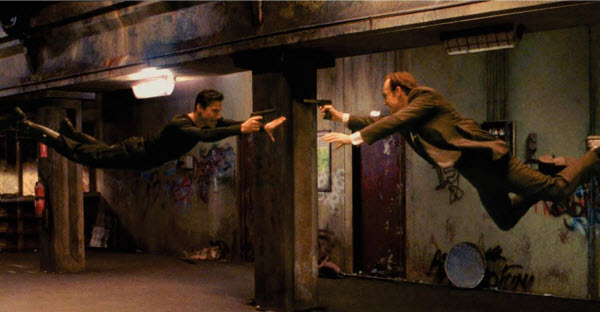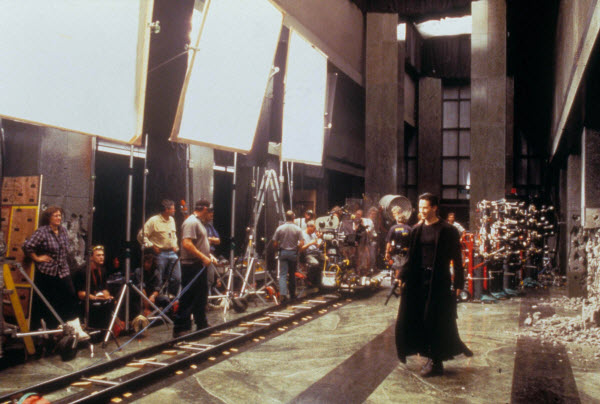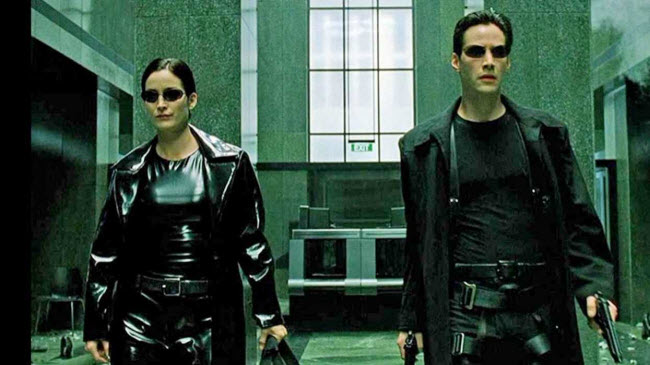The Matrix, directed by the Wachowskis and released in 1999, is a groundbreaking film that revolutionized the science fiction genre. With its innovative special effects, deep philosophical themes, and compelling narrative, it has become a seminal work in modern cinema. The film explores themes of reality, perception, and human existence, all while delivering a visually stunning and action-packed experience. Its impact on both popular culture and the film industry has been profound, making it a landmark achievement in cinematic history.
Plot Summary (Warning: Spoilers Ahead)

The Matrix follows the story of Thomas Anderson (Keanu Reeves), a computer programmer who leads a double life as a hacker under the alias Neo. Neo feels that something is wrong with the world but cannot quite put his finger on it. His suspicions are confirmed when he encounters a mysterious group led by Morpheus (Laurence Fishburne), who reveals that reality is not what it seems.
Morpheus introduces Neo to the truth: humanity is trapped in a simulated reality called “The Matrix,” created by sentient machines to subdue the human population while using their bodies as an energy source. The real world is a desolate wasteland, and the Matrix is a sophisticated virtual reality that masks this grim reality.
Neo is prophesied to be “The One,” a savior who will end the war between humans and machines and bring freedom to humanity. Throughout the film, Neo undergoes intense training and combat, learning to manipulate the Matrix’s rules. His journey culminates in a climactic battle against the agents of the Matrix, particularly Agent Smith (Hugo Weaving), as he embraces his role as The One and fights to liberate humanity.
The film concludes with Neo achieving an understanding of his powers, demonstrating his control over the Matrix, and making a commitment to fight for the freedom of humanity.
Main Characters and Actors
Neo (Keanu Reeves): The protagonist, who discovers the truth about the Matrix and becomes The One.
Morpheus (Laurence Fishburne): The leader of the resistance who believes Neo is the prophesied savior.
Trinity (Carrie-Anne Moss): A skilled hacker and Morpheus’s ally who becomes Neo’s love interest.
Agent Smith (Hugo Weaving): The main antagonist, an agent of the Matrix who seeks to eliminate Neo and maintain control.
Cypher (Joe Pantoliano): A disillusioned member of the resistance who betrays Neo and his team.
Oracle (Gloria Foster): A wise and enigmatic figure who provides guidance and insight to Neo and others.
Awards and Recognition
The Matrix was both a critical and commercial success, earning four Academy Awards for Best Film Editing, Best Sound, Best Sound Effects Editing, and Best Visual Effects. Its innovative special effects, including the groundbreaking use of “bullet time,” set new standards in the industry. The film’s success led to two sequels, solidifying its place in popular culture and influencing countless other films.
Trivia (100 Interesting Facts)

- Bullet Time: The film popularized the “bullet time” effect, where the camera appears to move around a slow-motion action sequence.
- Keanu Reeves’ Training: Keanu Reeves underwent extensive martial arts training for his role, including training in Kung Fu and other disciplines.
- Philosophical Influences: The film draws on various philosophical ideas, including concepts from Plato’s Allegory of the Cave and Descartes’ skepticism.
- The Red Pill or Blue Pill: The iconic choice between the red and blue pills symbolizes the decision to confront uncomfortable truths or remain in ignorance.
- Laurence Fishburne’s Role: Laurence Fishburne, who played Morpheus, was initially offered the role of Neo but chose to play Morpheus instead.
- Special Effects Innovation: The film’s use of CGI and practical effects was revolutionary and set new standards for visual storytelling.
- Agent Smith’s Role: Hugo Weaving’s portrayal of Agent Smith was heavily influenced by the character of HAL 9000 from 2001: A Space Odyssey.
- Martial Arts Choreography: Yuen Woo-ping, a renowned martial arts choreographer, was hired to design the fight sequences.
- Matrix Code: The green code seen in the Matrix is composed of characters from sushi recipes and other symbols.
- Red Pill Origin: The concept of the red pill was inspired by the comic book The Invisibles by Grant Morrison.
- Matrix Location: The scenes inside the Matrix were filmed on location in Sydney, Australia.
- Neo’s Choice: The choice Neo faces is often interpreted as a metaphor for enlightenment and self-realization.
- Cameo Appearance: The Oracle’s role was played by Gloria Foster, who was known for her work in stage and film.
- Subsequent Films: The success of The Matrix led to two sequels, The Matrix Reloaded and The Matrix Revolutions, released in 2003.
- Soundtrack Impact: The film’s soundtrack, featuring artists like Rage Against the Machine and Rob Dougan, became highly influential.
- Matrix Set Design: The film’s sets and production design were inspired by cyberpunk aesthetics and dystopian themes.
- Film Influence: The Matrix has influenced numerous films, television shows, and video games in its wake.
- Iconic Costume: Neo’s black trench coat and sunglasses have become iconic symbols associated with the film.
- Casting Decisions: Will Smith turned down the role of Neo, which eventually went to Keanu Reeves.
- Visual Effects Academy Award: The Matrix won the Academy Award for Best Visual Effects, a testament to its innovative approach.
- Choreography Challenges: The choreographed fight scenes required precise timing and coordination, which took extensive rehearsals.
- Neo’s Training: Keanu Reeves trained with martial arts experts for several months to prepare for his role.
- Virtual Reality Inspiration: The concept of virtual reality explored in the film was inspired by real-world advancements in technology.
- Wachowskis’ Vision: The Wachowskis initially pitched the film as a high-concept action film with deep philosophical undertones.
- Subtle Hints: The film features subtle references to its sequels, which expand on the story and themes introduced in the original.
- Film Editing: The film’s editing was designed to enhance the visual effects and storytelling, contributing to its immersive experience.
- Influence on Action Cinema: The Matrix’s action sequences and visual effects have been widely imitated in subsequent films and media.
- Neo’s Awakening: The scene where Neo wakes up in the real world was filmed in a grim, industrial setting to contrast with the Matrix.
- Philosophical Quotes: The film is rich with philosophical quotes and dialogue, reflecting its deep thematic content.
- Iconic Lines: The line “There is no spoon” has become a memorable quote symbolizing the film’s exploration of reality and perception.
- Famous Characters: The character of Neo has become one of Keanu Reeves’ most iconic roles in his career.
- Matrix Effects: The film’s use of green tint and digital effects helped create a distinct visual style that is instantly recognizable.
- Directorial Debut: The Matrix was the first major feature film directed by the Wachowskis, who gained widespread acclaim for their work.
- Cultural References: The film includes numerous references to cyberpunk culture and philosophy, enriching its narrative depth.
- Film Soundtrack: The soundtrack’s blend of electronic and rock music enhances the film’s futuristic and intense atmosphere.
- Keanu Reeves’ Preparation: Reeves spent months preparing for his role, including learning complex fight sequences and special effects techniques.
- Trinity’s Role: Carrie-Anne Moss’s portrayal of Trinity has been praised for its strength and depth, making her a standout character.
- Special Effects Legacy: The film’s groundbreaking use of CGI and practical effects influenced the future of action and science fiction cinema.
- Sofia Coppola’s Appearance: The film features a cameo by Sofia Coppola as a party guest.
- Wachowskis’ Inspiration: The Wachowskis were inspired by a wide range of sources, including anime, comics, and philosophical texts.
- Symbolic Imagery: The film uses symbolic imagery to convey its themes, such as the red and blue pills representing choice and awareness.
- The Matrix Franchise: The Matrix franchise includes animated shorts, comic books, and video games that expand on the film’s universe.
- Neo’s Evolution: Neo’s character arc reflects his journey from a disillusioned hacker to a messianic figure.
- Futuristic Design: The film’s futuristic design elements were influenced by the burgeoning cyberpunk genre.
- Iconic Sequences: The film’s action sequences, such as the lobby shootout, are considered among the most memorable in cinema history.
- Real-Life Influences: The concept of a simulated reality in the film draws on real-world discussions about the nature of consciousness and reality.
- Visual Innovation: The film’s innovative visual techniques, such as the use of slow-motion and camera angles, have become staples in action cinema.
- Film’s Impact: The Matrix has had a lasting impact on popular culture and continues to be referenced and parodied in various media.
49. Casting Choices: The casting of Keanu Reeves and Laurence Fishburne added depth and charisma to the film’s central characters. - Visual Effects Team: The visual effects team, including John Gaeta, received acclaim for their work on the film’s groundbreaking effects.
- Film’s Themes: The film explores themes of control, freedom, and the nature of reality through its complex narrative and philosophical questions.
- Matrix Reloaded: The Matrix Reloaded, the first sequel, further explores the themes and characters introduced in the original film.
- Production Design: The film’s production design incorporates elements of dystopian and cyberpunk aesthetics, creating a distinctive visual style.
- Soundtrack Success: The film’s soundtrack became a commercial success and was praised for its contribution to the film’s atmosphere.
- Influential Sequel: The sequels to The Matrix continued to explore and expand upon the film’s complex universe and themes.
- Film’s Reception: Upon release, the film received widespread acclaim for its innovative effects, storytelling, and performances.
- Neo’s Iconic Look: Neo’s black leather outfit and sunglasses have become iconic symbols associated with the film.
- Action Choreography: The film’s action choreography, including its innovative fight sequences, has been widely praised and influential.
- Cultural Impact: The film has had a significant cultural impact, influencing other films, television shows, and video games.
- Awards and Nominations: The Matrix won several awards and nominations for its technical achievements and storytelling.
- Film’s Legacy: The Matrix’s legacy endures through its influence on the science fiction genre and its continued relevance in popular culture.
- The Matrix’s World: The film’s world-building and lore have been explored and expanded in various spin-offs and media.
- Philosophical Depth: The film’s philosophical depth adds layers of meaning to its narrative, inviting viewers to question their own perceptions of reality.
- Keanu Reeves’ Impact: Keanu Reeves’s performance as Neo solidified his status as a leading action star in Hollywood.
- Influence on Action Films: The film’s influence on action cinema can be seen in the use of slow-motion and CGI techniques in later films.
- Iconic Moments: The film features several iconic moments, such as Neo’s realization of his powers and the bullet-dodging scene.
- Film’s Narrative: The film’s narrative structure and pacing contribute to its immersive and engaging storytelling.
- Matrix Universe: The Matrix universe includes a rich array of characters, settings, and concepts that have captivated audiences.
- Visual Style: The film’s visual style, including its use of color and lighting, enhances its thematic elements and atmosphere.
- Character Development: The development of characters like Neo, Morpheus, and Trinity adds depth to the film’s narrative.
- Film’s Influence: The Matrix has influenced a wide range of media, including films, television shows, and video games.
- Film’s Themes: The exploration of freedom and control is central to the film’s themes and narrative.
- Matrix Legacy: The Matrix legacy continues to be felt through its impact on popular culture and its continued relevance in discussions about technology and reality.
- Visual Techniques: The film’s use of visual techniques, such as slow-motion and special effects, has become iconic in its own right.
- Keanu Reeves’ Performance: Keanu Reeves’s portrayal of Neo is widely regarded as one of his most memorable and influential roles.
- Film’s Cinematography: The cinematography of The Matrix enhances its visual storytelling and thematic elements.
- Matrix World: The film’s depiction of the Matrix as a simulated reality challenges viewers’ perceptions of their own world.
- Cultural Impact: The film’s cultural impact is evident in its continued popularity and influence across various media.
- Philosophical Exploration: The film’s philosophical exploration of reality and perception continues to resonate with audiences.
- Special Effects Team: The special effects team’s work on The Matrix has been praised for its innovation and technical achievements.
- Matrix’s Impact: The Matrix’s impact on the science fiction genre is profound, with its influence evident in subsequent films and media.
- Film’s Innovation: The film’s innovation in visual effects and storytelling has set new standards in the industry.
- Neo’s Journey: Neo’s journey from ordinary hacker to savior is a central theme of the film, highlighting personal growth and transformation.
- Film’s Score: The film’s score, composed by Don Davis, complements its action and thematic elements.
- Matrix’s Legacy: The Matrix’s legacy extends beyond the film itself, influencing various aspects of popular culture.
- Cinematic Techniques: The film’s use of cinematic techniques, including innovative camera work and effects, has been highly influential.
- Character Dynamics: The dynamics between characters like Neo, Morpheus, and Trinity contribute to the film’s depth and complexity.
- Film’s Reception: The film’s reception upon release was overwhelmingly positive, with praise for its effects, story, and performances.
- Influence on Technology: The film’s exploration of technology and virtual reality has had a lasting impact on discussions about the future of technology.
- The Matrix Franchise: The Matrix franchise continues to expand its universe through films, comics, and other media.
- Film’s Themes: The themes of reality, freedom, and control are central to the film’s narrative and appeal.
- Cultural References: The film’s cultural references and allusions add layers of meaning to its story and themes.
- Film’s Style: The film’s distinctive style, including its visual effects and action sequences, has become iconic.
- Matrix Universe: The Matrix universe is rich and complex, offering a wide range of characters and concepts.
- Film’s Legacy: The film’s legacy is marked by its influence on both the science fiction genre and popular culture.
- Special Effects Impact: The impact of the film’s special effects is evident in its continued influence on visual storytelling.
- Neo’s Character Arc: Neo’s character arc is central to the film’s narrative, highlighting themes of self-discovery and transformation.
- Film’s Influence: The film’s influence extends to various aspects of popular culture, including films, television shows, and video games.
- Iconic Scenes: The film features several iconic scenes that have become cultural touchstones.
- Matrix’s Relevance: The Matrix remains relevant and influential, continuing to captivate audiences with its themes and innovations.
- Matrix’s Relevance: The Matrix remains relevant and influential, continuing to captivate audiences with its themes and innovations.
